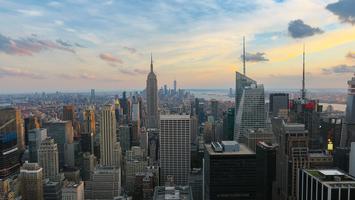
A recent blog post by investor and stand-up comedian James Altucher (mentioned here) arguing that New York is dead forever attracted the hostility of many New Yorkers. Fellow comedian Jerry Seinfeld wrote a New York Times op-ed calling Altucher a “whimpering putz.” Mayor De Blasio, naturally, agrees with Seinfeld.
The New York Post told Altucher to “drop dead,” noting that, if he really loved the city as he claims (he co-owns a comedy club there), he would stay and do his part to revive it. Guardian columnist Arwa Mahdawi suggests that New York is not only not dying, “the rich are moving out and the city is being reborn.”
With all due respect to these people, they missed Altucher’s point. New York as a city will survive. But New York as an ideal, a place that builds wealth and fulfills dreams like nowhere else in America, will not. Not to put too many words in Altucher’s mouth, what is really dead is the idea that New York City or Manhattan densities are necessary have a healthy economy and diverse culture.
Altucher pointed out that the pandemic has taught high-income people that they don’t need to deal with the congestion, high costs of living, homeless people, crime, and other stresses of the densest city in America. The things that made New York attractive are disappearing: lots of restaurants are permanently closed; lots of entertainment businesses promise to reopen next year, but no one knows if they will.
Mahdawi and others may be smugly happy to see rich people leave, which she hopes will make the city more affordable. But those rich people provide the start-up capital and the initial demand for all of the businesses that made New York City exciting.
The key to any thriving economy is exports, and what New York City exported was money. If the owners of that money decide they don’t have to be in New York City to export it, then the city loses the biggest driver of its economy.
The big danger is that the city will still be unaffordable after the wealthy people have left. Sure, rents will decline, but not enough to make it truly affordable. In 2017, median home prices in Manhattan were more than a million dollars, which was 9.4 times median family incomes. To be “affordable” (i.e., less than three times incomes) home prices would have to drop by more than two-thirds — much more if the exodus of high-income people pushes down median family incomes.
New York City’s construction costs have been the highest in the world. The people who paid those costs to build housing aren’t going to accept 25 percent or less of what they were expecting for the condos and apartments they have built. Instead, they’ll figure out other uses for that space and it won’t be available as housing.
A few weeks ago, I participated in a debate with market urbanist Scott Beyer over housing and land-use regulation, and Beyer’s main argument was that density has a value to businesses and personal interactions. It is quite likely that the COVID-19 virus has reduced that value to less than its cost.
Read the rest of this piece at The Antiplanner.
Randal O'Toole (rot@ti.org) is a Cato Institute Senior Fellow working on urban growth, public land, and transportation issues. He is the author of numerous Cato papers and has also written for numerous other national journals and newspapers.
Photo credit: JaxsonD via Wikimedia under CC 4.0 License












